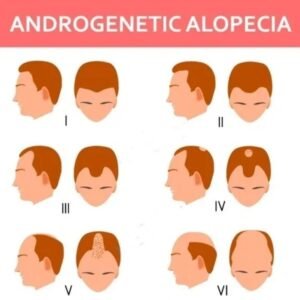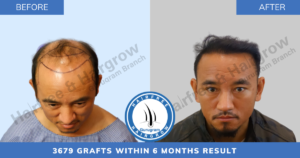Androgenetic Alopecia (Male & Female Pattern Baldness)
What is Androgenetic Alopecia?
This is the most common cause of male hair loss. Androgenetic alopecia is inherited from parents. As a result, one should look to their relatives to see if there have been instances of hair loss that move in the family. Androgenetic alopecia is characterised by progressive hairline thinning on the scalp.

The downturn of temporal hair or loss of side hair is the first sign of AGA. Furthermore, as the condition worsens, hair loss moves and eventually covers the entire crown. The most major reason for hair loss in men is hormonal changes caused by androgens. This is easily changed with medications and some other non-surgical procedures.This condition is easily reversible with FUE and FUT hair transplants.
Hairfree and Hairgrow will help you step forward with a 100% success rate, and you will regard this problem as a bad dream.
Androgenic alopecia in Female
In contrast to male-pattern baldness, women lose their hair in a different pattern. While the hairline does not recede, women’s hair thins down all over their heads. Women with androgenetic alopecia rarely develop complete baldness.
Androgenic alopecia in Male
Men’s androgenetic alopecia has been linked to a number of different illnesses, such as coronary heart disease and prostate enlargement. Androgenetic alopecia has also been linked to prostate cancer, insulin resistance conditions (such diabetes and obesity), and high blood pressure (hypertension). This type of hair loss in women is linked to a higher incidence of polycystic ovary syndrome (PCOS). A hormonal imbalance that can result in irregular menstruation, acne, extra body hair (hirsutism), and weight gain is what PCOS is known for.
When the Androgenic Alopecia starts in Men & Women?
Androgenetic alopecia is a frequent cause of hair loss in both men and women. This form of hair loss affects an estimated 50 million men and 30 million women in the United States. Androgenetic alopecia can start as early as a person’s teens and risk increases with age; more than 50 percent of men over age 50 have some degree of hair loss. In women, hair loss is most likely after menopause.
Reasons behind the Alopecia
According to research, androgen hormones, notably dihydrotestosterone, are responsible for this particular type of hair loss. Androgens play a crucial role in male sexual development during puberty and before delivery. Additionally, androgens play crucial roles in the regulation of hair growth and sex drive in both men and women.
Follicles, which are found beneath the epidermis, are where hair development starts. Each hair strand typically develops for two to six years before entering a resting period for a few months and then falling out. When the follicle starts to develop a new hair, the cycle repeats. Increased androgen levels in hair follicles can shorten the hair growth cycle and cause the development of shorter and thinner strands of hair. In addition, the creation of new hair to replace strands that fall out is delayed.
Despite the fact that multiple genes may be involved in androgenetic alopecia, only one gene variant, AR, has been proven in research. The androgen receptor protein is made according to instructions from the AR gene. The body may react correctly to androgens like dihydrotestosterone and other androgens thanks to androgen receptors. According to studies, androgen receptor activity in hair follicles is raised as a result of polymorphisms in the AR gene. However, how these genetic alterations enhance the incidence of hair loss in both men and women with androgenetic alopecia is yet unknown.
Other Names for This Condition Section
Hair Loss
⦿ About Hair Loss
⦿ Male Hair Loss
⦿ Female Hair Loss
⦿ Androgenetic Alopecia
⦿ Alopecia Areata
⦿ Traction Alopecia
⦿ Anagen Effluvium
⦿ Telogen Effluvium
⦿ Cicatricial Alopecia
⦿ Folliculitis
Before and After








